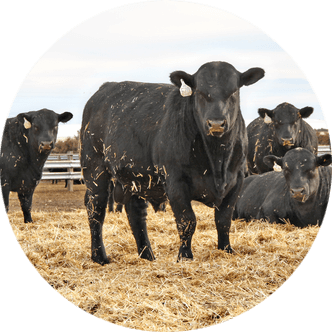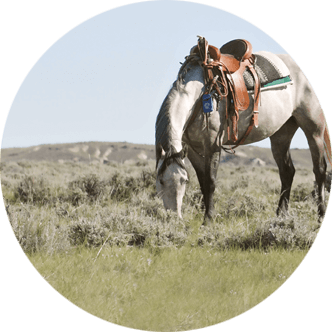Provenza explains palatability
Lusk — “Where do preferences come from and why do creatures do what they do?” Dr. Fred Provenza of Utah State University asked his audience of producers in Lusk Feb. 2.
He also asked attendees to consider how animals continually adapt and what the resulting management implications should be.
“Behavior by consequences and adaptation in the here and now are parts of the answer,” said Provenza, adding, “The behavior you see at any point in time is reflecting the consequences of the animal. First impressions matter a lot, just as they do in humans or bacteria.”
Powerful influences occur all the time from generation to generation and producers see changes through selection. In wild species mutations occur and if they are advantageous they may be added to the gene pool. These changes aren’t necessarily in the genome but rather in what is being expressed in the genome.
Different sequences are being turned off and on in the here and now as changes occur. Animals need something that’s constantly changing to keep up with the changes in the world. Genes are talking to biophysical and social environments and all those interactions create an individual, said Provenza.
Provenza explained health and nutrition are where food is utilized and involves the need provided by cells and organs. Animals with similar genetics and physiology may differ in behavior and these differences may result in one animal surviving much better than the other one, due to how it mixes diet, lifestyle, culture, landscape and what it finds palatable.
“Palatability is more than a matter of taste. Palatability is the relationship between flavor and postingestive feedback from cells and organs in response to primary and secondary compounds. Palatability is a relationship. Nutrients go to the cells, and through hormones, neurotransmitters and nerves, cells tell the palette what it does and doesn’t need. Liking is influenced by need,” explained Provenza.
Nutritional value increases palatability to animals. An example of this was expressed in a research project involving goats and flavored straw. Mildly energy deprived goats were separated into two groups and fed apple- and maple-flavored straw on alternate days. After eating, animals were drenched with either water or a mixture containing one percent starch to help meet their energy needs. Group one was drenched with starch after eating maple-flavored straw and with water after eating apple-flavored straw. The opposite was done with group two.
After only four cycles the goats in each group formed a strong affinity for the straw that coincided with the nutrient drench over the straw combined with the water drench.
“Understanding how palatability and feedback from primary and secondary compounds are related can improve the health of herbivores and landscapes,” said Provenza.
Sheep have been trained to forage in vineyards and to avoid certain plants due to negative feedback. Provenza explained sodium chloride is used to induce what is believed to be nausea in the sheep. They then associate the nausea with the plant they obtained it from and will avoid it after the first experience.
Using this technique results in sheep that will graze vineyards but leave grape leaves alone. This improves forage and soil quality and provides a source of fertilization as well. There is currently an active program working on using this technique to graze forests with sheep also. Similar techniques have been used to train cattle and horses to avoid poisonous plants.
Animals can also be trained to eat forages they normally wouldn’t, stated Provenza. An example of this is training livestock to eat sagebrush. Overgrowth of sagebrush results in reduced productivity of rangelands. High terpenoid (terpene) levels found in the plant decrease composition rates in soil and can slow down the nutrient cycling system. Sagebrush is also critical habitat for a variety of species.
Grazing sagebrush is alternate form of management that Provenza says can be used to increase productivity and diversity of rangelands.
“The bigger idea is that there isn’t a plant more abundant than sagebrush and there probably isn’t’ a plant less used than sagebrush. Can we train cattle locally to eat this?” asked Provenza.
Research projects are showing that it can be done. In 2001 Provenza was involved in a trial involving sheep. “The first year sagebrush won and sheep lost,” he commented.
In 2003 the trial was modified through increasing stock density and providing protein and energy supplementation. The sheep were much more successful that time. Provenza credits the creation of positive feedback through supplementation as part of the reason. The supplement helped the liver eliminate the higher toxicity levels created by ingesting high amounts of terpene.
“There were more sheep eating more sagebrush per sheep due to these changes,” explained Provenza.
Other sagebrush facts discovered through research have further aided grazing studies. Provenza showed a graph representing terpene levels throughout the year. It showed that terpene production is reduced in fall and winter after a hard frost. Animals will increase utilization of the plant during that time period. Grazing during that time of the year also results in minimal impact on grasses and forbs. The result is a huge increase in productivity and biodiversity.
There are also behavioral differences in plants. Young plants have high concentrations of secondary compounds, which include terpenes. These high levels provide protection for the plant and help it reach maturity faster. Adult plants have lower terpene levels. This explains why animals won’t consume young sagebrush, despite it appearing more palatable according to Provenza.
“We look at individual animals when they go on and come off these grazing projects. They are all over the board. Some gain weight and some lose weight. It’s not necessarily that the good doing cows are eating more sagebrush, it’s that they know how to hustle and are utilizing the landscape differently,” said Provenza.
He added that these projects are currently being scaled up to the landscape level in Utah and neighboring states. Bands of sheep are being used in intensive situations to strategically create patches of sagebrush. “We’re slowly, strategically rejuvenating landscapes. The idea is to not view domestic animals as we would an herbicide treatment where we do it once and then 10 years later come back, but to integrate livestock into the landscape and how it’s managed year-in and year-out.”
Additional benefits to grazing sagebrush include the creation of more desirable wildlife habitat. “The old, dead skeletons provide structure and are just what birds need. Patchiness of structure is so important for birds like the sage grouse to do what they need to. We’re also working within species to create different types of habitat that are needed from season to season,” explained Provenza.
“One of our big interests is taking these ideas and putting them into practice,” explained Provenza. “We’ve worked hard over the years and had to think hard to come up with this. It will take effort to move from understanding into practice too.”
Heather Hamilton is editor of the Wyoming Livestock Roundup and can be reached at heather@wylr.net





